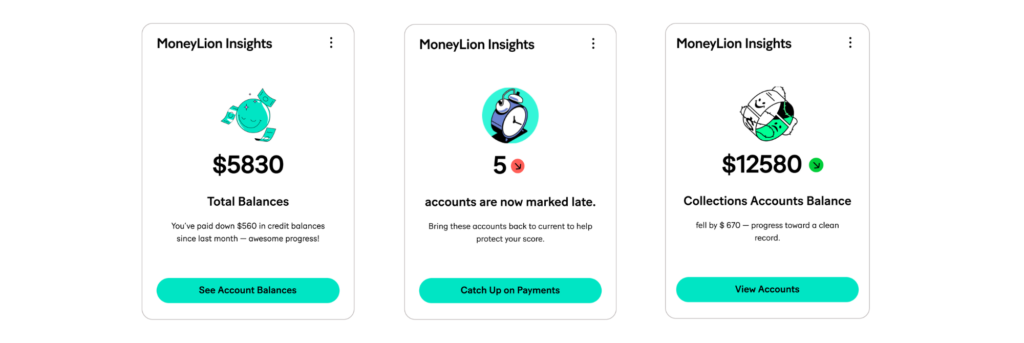If juggling multiple credit card payments feels overwhelming, consolidating your debt could be the solution you need. By combining your balances into a single payment, you can simplify your finances, potentially lower your interest rate, and set yourself on a clearer path to becoming debt-free. Let’s explore the steps to effectively consolidate your credit card debt and regain control over your financial situation.
And keep reading to see how you can get personalized offers from our trusted partners through MoneyLion!
Table of contents
What is credit card debt consolidation?
OK, let’s break it down. Credit card debt consolidation is like giving your financial life a much-needed makeover. Instead of juggling multiple credit card bills with sky-high interest rates, you lump them into one manageable payment. Think of it as herding your debt cats into a single pen. There are several ways to achieve this, each with flavor and flair. Here’s the lowdown on the most popular strategies.
8 ways to consolidate credit card debt
Ready to explore your options? Here’s a buffet of strategies to help you consolidate credit card debt and regain control.
1. Personal loans
Ever thought of taking out a fixed-rate loan to pay off those credit card balances? Personal loans often come with lower interest rates than your typical credit card. Plus, they give you a structured repayment plan so you know exactly when you’ll be debt-free. Not only do you get a clear end date, but you also avoid the variable rates that can make credit card debt so unpredictable.
Pro tip: Shop around for the best rates and terms.
Con: If you have poor credit, you might face higher interest rates or struggle to get approved.
2. Balance transfer credit cards
Got good to excellent credit? Balance transfer cards can be your best friend. Transfer your high-interest debt to a new card with a low or even 0% introductory APR. This move can save you a ton in interest if you pay off the balance within the promo period. It’s a strategic way to buy breathing room without accruing additional interest.
Watch out: Balance transfer fees and short introductory periods can sometimes bite you if you’re not careful. Read the fine print and plan your repayment schedule to avoid paying high interest once the introductory period ends.
3. Home equity loan or line of credit (HELOC)
If you’re a homeowner, you can borrow against your home’s equity to pay off your credit card debt. These loans usually offer lower interest rates since your home secures them. It’s a way to turn your real estate investment into a financial tool.
Caution: If you default, you risk foreclosure. This is a high-stakes game, folks. Having a solid repayment plan is essential and avoiding using your home as collateral unless you’re confident in your ability to repay the loan.
4. Debt management plans
Working with a credit counseling agency can streamline your debt repayment. These agencies negotiate lower interest rates with your creditors and set you up with a manageable monthly payment. They also provide financial education to help you avoid falling into debt in the future.
Bonus: It simplifies your payments. Instead of dealing with multiple creditors, you make one payment to the agency, which distributes the funds.
Drawback: It might impact your credit score, and fees could be involved. Additionally, you’ll need to close your credit card accounts, which could lower your credit utilization ratio and temporarily hurt your credit score.
5. 401(k) loans
Desperate times call for desperate measures, like borrowing from your retirement savings. No credit check is required, but you risk your future. Using your 401(k) as a piggy bank can jeopardize your retirement and come with tax penalties if not repaid on time.
Heads-up: If you leave your job, you’ll have to repay the loan quickly, or it’ll be considered a withdrawal, subject to taxes and penalties. Given the potential long-term impact on your retirement funds, this option should be a last resort.
6. Peer-to-peer (P2P) lending
Why not borrow from real people? P2P lending platforms match borrowers with individual lenders, often offering competitive rates. These platforms can be more flexible than traditional banks, and you might find better terms.
Perk: The process can be quicker than traditional loans. Plus, P2P platforms often cater to a wider range of credit profiles, offering options even if your credit isn’t perfect.
Downside: Interest rates can vary widely, and good credit scores typically get the best deals. Always check the platform’s reputation and read reviews before committing.
7. Life insurance policy loans
Got a permanent life insurance policy with cash value? You can borrow against it without a credit check. But remember, unpaid loans reduce your death benefit, which could affect your beneficiaries.
Plus: No rush to repay. The loan isn’t due until the policy matures, which can give you some financial flexibility.
Minus: It impacts your policy’s value. If you don’t repay the loan, it will be deducted from the death benefit, potentially leaving your loved ones with less financial support.
8. Auto equity loans
If you’ve paid off your vehicle, you can use it as collateral for a loan. These loans usually have lower interest rates than credit cards. They can leverage your assets without dipping into your home equity.
Risk: Defaulting means losing your car, which could be a serious bummer if you rely on it for daily transportation. Ensure that the loan terms are clear and manageable within your budget.
👉 Budgeting Tips to Avoid Credit Card Debt
Should I consolidate my credit card debt?
Now that you’ve got the options, the question is: should I consolidate my credit card debt? Here are some compelling reasons to consider and a few cautionary notes.
Reasons to consider consolidation
- High interest rates on current cards: If your credit card interest rates are sky-high, consolidating could lower your overall interest.
- Struggling with multiple monthly payments: Consolidation means one payment instead of several, making your financial life simpler and less stressful.
- Difficulty tracking various due dates: Forget juggling multiple due dates; one payment is way easier to manage and reduces the risk of missed payments.
- Potential for lower overall interest rate: Many consolidation options offer lower rates than credit cards, reducing the total amount you’ll pay over time.
- Simplification of debt management: One payment, one plan. Need we say more? Simplifying your debt can make staying on track and motivated to pay off your balances easier.
When to be cautious
- Good credit required for best options: The top deals are usually reserved for those with good credit scores. You might not qualify for the best rates if your credit isn’t great.
- Potential fees associated with consolidation: Balance transfers, personal loans, and counseling services might come with fees. Always factor these into your decision-making process.
- Risk of accumulating new debt: If you’re not careful, you might run up new balances on your paid-off cards, putting you in a worse position than before.
- Possible longer repayment terms: Consolidation can extend your repayment period, meaning more interest over time. Be sure to understand the terms and how they affect your total repayment amount.
- Some options may put assets at risk: Home equity loans and auto equity loans put your property on the line. Make sure you’re comfortable with the risks involved.
Taming the Debt Beast
So, there you have it! Armed with these strategies, you can tackle your credit card debt head-on and regain control of your financial future. Remember, consolidation is just one tool in your financial toolbox. Stay disciplined, avoid running up new debt, and you very well could be on the path to a brighter, debt-free future in no time.
Your Top Insights

Interest adds up daily—the longer you wait, the more you pay.
FAQs
What is the best way to consolidate credit card debt?
The best method depends on your financial situation. Personal loans and balance transfer cards are popular because of their lower interest rates, but options like HELOCs or debt management plans can also be effective.
How do you consolidate credit card debt?
Assess your debt and credit score. Then, choose a debt consolidation method like a personal loan, balance transfer, or debt management plan. Apply for your chosen method and use the funds to pay off your credit card balances.
How does credit card debt consolidation work?
Debt consolidation involves combining multiple credit card debts into a single payment. This can be done through loans, balance transfers, or management plans, often resulting in lower interest rates and simplified payments.







